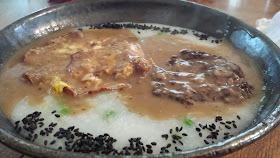Here's how you can make loco moco congee, too.
First, make bai zhou, plain white rice congee: bring to a boil a cup of white rice with five to eight cups of water, depending on how thick you like your congee. Once it's boiled, reduce the heat to a simmer, and allow to simmer until the grains have begun to lose their borders and the bai zhou is porridgey in consistency.
 |
| Here's what my bai zhou looks like after about 25 or 30 minutes of simmering. The rice grains are still more or less distinct, but you can't quite tell where one grain ends and another begins. |
 |
| Here's what longer-cooked (one hour or more) congee looks like (along with some hei zhi ma for a garnish and some greens mixed in)--no distinction whatsoever between the rice grains. Neither way is more right--it's really about your preference. |
Lightly salt and pepper about one quarter of a pound of ground beef--Adam used grass-fed ground chuck, 80% lean. Gently form a patty with your hands.
Preheat a cast-iron skillet on high heat. Put your patty in the skillet and cook it for about 3-4 minutes a side. There's no need to oil your pan first. Don't touch it at all for at least the first couple of minutes on each side; Adam insists: "It'll let go of the pan when it's ready." During those first couple of minutes, you're building a nice crust on the outside of the burger and also building up the fond, the nice crusty bits that are left stuck in the pan that will be the basis for your flavorful gravy.
Take burger out and set it aside, or just set it on top of a bowl of bai zhou.
Take the pan off the heat, let it cool a bit. There will be some fat in the pan that has come off of the ground beef. If it's more than a couple of tablespoons, remove some fat. If it's less, add some butter to make up a couple tablespoons of fat total. Then return the pan to medium heat and whisk in two or so tablespoons of flour; whisk (or stir with a wooden spoon) for two to three minutes till the flour starts to brown a little bit. Gradually whisk in beef or chicken stock (we used chicken stock)* very slowly--make sure each bit of stock is smoothly incorporated before adding more. Continue adding stock, more or less a cup in total until you have your gravy at the consistency you like it.
*It's worth noting that if you're not making your stock at home, storebought chicken stock is generally far superior to storebought beef stock.
In another pan, cook an egg over-easy.
Assemble your loco moco congee: bai zhou in a wide bowl, then hamburger patty, then egg; top it all with gravy. Season with salt and pepper to taste, plus hei zhi ma if you like. Enjoy.
 |
| OMG, you guys. |
Jenjen called me from a visit home to Honolulu all outraged; she'd gotten a loco moco somewhere, but they'd cooked the egg all the way through. "Then it's not a loco moco!" I shouted, instantly beside myself on her behalf. "I KNOW!" wailed Jenjen. "Do it right, or like, what's the POINT?")
I love that Jenjen knew that she'd get a sympathetic ear, calling me about an improperly executed loco moco.I'm not saying you can't mess around with your loco moco--I mean, I'm messing around with it just having it over congee, or suggesting you have it with turkey and kale and no gravy. But all that being said, no matter what I do to your loco moco, I promise, gravely and sincerely, that I will never, ever, ever serve it to you with an overcooked egg.

No comments:
Post a Comment